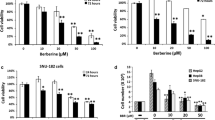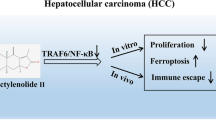Abstract
Taraxasterol has potent anti-inflammatory and anti-tumor activity. However, the effect and potential mechanisms of Taraxasterol on the growth of human liver cancer have not been clarified. Histidine triad nucleotide-binding protein 1 (Hint1) is a tumor suppressor and its downregulated expression is associated with the development of cancer. Here, we report that Taraxasterol treatment significantly suppressed cell proliferation and induced cell cycle arrest at G0/G1 phase and apoptosis in liver cancer cells, but not in non-tumor hepatocytes. Furthermore, Taraxasterol upregulated Hint1 and Bax, but downregulated Bcl2 and cyclin D1 expression, accompanied by promoting the demethylation in the Hint1 promoter region in liver cancer cells. The effects of Taraxasterol were abrogated by Hint1 silencing and partially mitigated by Bax silencing, Bcl2 or cyclin D1 over-expression in HepG2 cells. Moreover, oral administration with Taraxasterol did not affect body weight, urinary protein levels, and the heart, liver, and kidney morphology in BALB/c mice but effectively inhibited the growth of implanted SK-Hep1 tumor in vivo. Collectively, we demonstrate that Taraxasterol inhibits the growth of liver cancer at least partially by enhancing Hint1 expression to regulate Bax, Bcl2, and cyclin D1 expression. Taraxasterol may be a drug candidate for the treatment of human liver cancer.
Key messages
-
Taraxasterol inhibits growth and induces apoptosis in human liver cancer cells.
-
Taraxasterol enhances Hint1 expression by promoting demethylation in Hint1 promoter.
-
Taraxasterol increases Hint1 levels to regulate Bax, Bcl2, and cyclinD1 expression.
-
The effects of Taraxasterol are abrogated by Hint1 silencing in liver cancer cells.
-
Taraxasterol inhibits the growth of subcutaneously implanted liver cancers in mice.






Similar content being viewed by others
References
Ferlay J, Soerjomataram I, Dikshit R, Eser S, Mathers C, Rebelo M, Parkin DM, Forman D, Bray F (2015) Cancer incidence and mortality worldwide: sources, methods and major patterns in GLOBOCAN 2012. Int J Cancer 136:E359–E386
Maucort-Boulch D, de Martel C, Franceschi S, Plummer M (2018) Fraction and incidence of liver cancer attributable to hepatitis B and C viruses worldwide. Int J Cancer 142:2471–2477
Bruix J, Sherman M (2011) Management of hepatocellular carcinoma: an update. Hepatology 53:1020–1022
Ke Y, Bao T, Zhou Q, Wang Y, Ge J, Fu B, Wu X, Tang H, Shi Z, Lei X, Zhang C, Tan Y, Chen H, Guo Z, Wang L (2017) Discs large homolog 5 decreases formation and function of invadopodia in human hepatocellular carcinoma via Girdin and Tks5. Int J Cancer 141:364–376
Ke Y, Bao T, Wu X, Tang H, Wang Y, Ge J, Fu B, Meng X, Chen L, Zhang C, Tan Y, Chen H, Guo Z, Ni F, Lei X, Shi Z, Wei D, Wang L (2017) Scutellarin suppresses migration and invasion of human hepatocellular carcinoma by inhibiting the STAT3/Girdin/Akt activity. Biochem Biophys Res Commun 483:509–515
Sharma K, Zafar R (2015) Occurrence of taraxerol and taraxasterol in medicinal plants. Pharmacogn Rev 9:19–23
Koo HN, Hong SH, Song BK, Kim CH, Yoo YH, Kim HM (2004) Taraxacum officinale induces cytotoxicity through TNF-alpha and IL-1alpha secretion in Hep G2 cells. Life Sci 74:1149–1157
Guo JB, Ye HH, Chen JF (2015) Anti-proliferation effect of Taraxacum mongolicum extract in HepG2 cells and its mechanism. Zhong Yao Cai 38:2129–2133
Yoon JY, Cho HS, Lee JJ, Lee HJ, Jun SY, Lee JH, Song HH, Choi S, Saloura V, Park CG, Kim CH, Kim NS (2016) Novel TRAIL sensitizer Taraxacum officinale F.H. Wigg enhances TRAIL-induced apoptosis in Huh7 cells. Mol Carcinog 55:387–396
Zhang X, Xiong H, Liu L (2012) Effects of taraxasterol on inflammatory responses in lipopolysaccharide-induced RAW 264.7 macrophages. J Ethnopharmacol 141:206–211
Xiong H, Cheng Y, Zhang X (2014) Effects of taraxasterol on iNOS and COX-2 expression in LPS-induced RAW 264.7 macrophages. J Ethnopharmacol 155:753–757
Jiang SH, Ping LF, Sun FY, Wang XL, Sun ZJ (2016) Protective effect of taraxasterol against rheumatoid arthritis by the modulation of inflammatory responses in mice. Exp Ther Med 12:4035–4040
Xueshibojie L, Duo Y, Tiejun W (2016) Taraxasterol inhibits cigarette smoke-induced lung inflammation by inhibiting reactive oxygen species-induced TLR4 trafficking to lipid rafts. Eur J Pharmacol 789:301–307
Takasaki M, Konoshima T, Tokuda H, Masuda K, Arai Y, Shiojima K, Ageta H (1999) Anti-carcinogenic activity of Taraxacum plant. I. Biol Pharm Bull 22:602–605
Takasaki M, Konoshima T, Tokuda H, Masuda K, Arai Y, Shiojima K, Ageta H (1999) Anti-carcinogenic activity of Taraxacum plant. II. Biol Pharm Bull 22:606–610
Dai J, Zhao C, Zhang Q, Liu ZL, Zheng R, Yang L (2001) Taraxastane-type triterpenoids from Saussurea petrovii. Phytochemistry 58:1107–1111
Lee DY, Jung L, Park JH, Yoo KH, Chung IS, Baek NI (2010) Cytotoxic triterpenoids from cornus kousa fruits. Chem Nat Compd 46:142–145
Wang L, Zhang Y, Li H, Xu Z, Santella RM, Weinstein IB (2007) Hint1 inhibits growth and activator protein-1 activity in human colon cancer cells. Cancer Res 67:4700–4708
Wang L, Li H, Zhang Y, Santella RM, Weinstein IB (2009) HINT1 inhibits beta-catenin/TCF4, USF2 and NFkappaB activity in human hepatoma cells. Int J Cancer 124:1526–1534
Zhang YJ, Li H, Wu HC, Shen J, Wang L, Yu MW, Lee PH, Bernard Weinstein I, Santella RM (2009) Silencing of Hint1, a novel tumor suppressor gene, by promoter hypermethylation in hepatocellular carcinoma. Cancer Lett 275:277–284
Weiske J, Huber O (2006) The histidine triad protein Hint1 triggers apoptosis independent of its enzymatic activity. J Biol Chem 281:27356–27366
Genovese G, Ghosh P, Li H, Rettino A, Sioletic S, Cittadini A, Sgambato A (2012) The tumor suppressor HINT1 regulates MITF and beta-catenin transcriptional activity in melanoma cells. Cell Cycle 11:2206–2215
Weiske J, Huber O (2005) The histidine triad protein Hint1 interacts with Pontin and Reptin and inhibits TCF-beta-catenin-mediated transcription. J Cell Sci 118:3117–3129
Massague J (2004) G1 cell-cycle control and cancer. Nature 432:298–306
John AA, Prakash R, Kureel J, Singh D (2018) Identification of novel microRNA inhibiting actin cytoskeletal rearrangement thereby suppressing osteoblast differentiation. J Mol Med (Berl) 96:427–444
Wu XS, Bao TH, Ke Y, Sun DY, Shi ZT, Tang HR, Wang L (2016) Hint1 suppresses migration and invasion of hepatocellular carcinoma cells in vitro by modulating girdin activity. Tumour Biol 37:14711–14719
Weiss LM, Hugle M, Romero S, Fulda S (2016) Synergistic induction of apoptosis by a polo-like kinase 1 inhibitor and microtubule-interfering drugs in Ewing sarcoma cells. Int J Cancer 138:497–506
Wu J, Ding Y, Chen CH, Zhou Z, Ding C, Chen H, Zhou J, Chen C (2016) A new oridonin analog suppresses triple-negative breast cancer cells and tumor growth via the induction of death receptor 5. Cancer Lett 380:393–402
Chatterjee SJ, Ovadje P, Mousa M, Hamm C, Pandey S (2011) The efficacy of dandelion root extract in inducing apoptosis in drug-resistant human melanoma cells. Evid Based Complement Alternat Med 2011:129045
Ovadje P, Chatterjee S, Griffin C, Tran C, Hamm C, Pandey S (2011) Selective induction of apoptosis through activation of caspase-8 in human leukemia cells (Jurkat) by dandelion root extract. J Ethnopharmacol 133:86–91
Ovadje P, Hamm C, Pandey S (2012) Efficient induction of extrinsic cell death by dandelion root extract in human chronic myelomonocytic leukemia (CMML) cells. PLoS One 7:e30604
Ovadje P, Chochkeh M, Akbari-Asl P, Hamm C, Pandey S (2012) Selective induction of apoptosis and autophagy through treatment with dandelion root extract in human pancreatic cancer cells. Pancreas 41:1039–1047
Ovadje P, Ammar S, Guerrero JA, Arnason JT, Pandey S (2016) Dandelion root extract affects colorectal cancer proliferation and survival through the activation of multiple death signalling pathways. Oncotarget 7:73080–73100
Sigstedt SC, Hooten CJ, Callewaert MC, Jenkins AR, Romero AE, Pullin MJ, Kornienko A, Lowrey TK, Slambrouck SV, Steelant WF (2008) Evaluation of aqueous extracts of Taraxacum officinale on growth and invasion of breast and prostate cancer cells. Int J Oncol 32:1085–1090
Chang J, Hsu Y, Kuo P, Kuo Y, Chiang L, Lin C (2005) Increase of Bax/ Bcl-XL ratio and arrest of cell cycle by luteolin in immortalized human hepatoma cell line. Life Sci 76:1883–1893
Choi YH, Kong KR, Kim YA, Jung KO, Kil JH, Rhee SH, Park KY (2003) Induction of Bax and activation of caspases during beta-sitosterol-mediated apoptosis in human colon cancer cells. Int J Oncol 23:1657–1662
Lee YN, Nechushtan H, Figov N, Razin E (2004) The function of lysyl-tRNA synthetase and Ap4A as signaling regulators of MITF activity in FcepsilonRI-activated mast cells. Immunity 20:145–151
Yannay-Cohen N, Carmi-Levy I, Kay G, Yang CM, Han JM, Kemeny DM, Kim S, Nechushtan H, Razin E (2009) LysRS serves as a key signaling molecule in the immune response by regulating gene expression. Mol Cell 34:603–611
Motzik A, Amir E, Erlich T, Wang J, Kim BG, Han JM, Kim JH, Nechushtan H, Guo M, Razin E, Tshori S (2017) Post-translational modification of HINT1 mediates activation of MITF transcriptional activity in human melanoma cells. Oncogene 36:4732–4738
Cen B, Li H, Weinstein IB (2009) Histidine triad nucleotide-binding protein 1 up-regulates cellular levels of p27KIP1 by targeting ScfSKP2 ubiquitin ligase and Src. J Biol Chem 284:5265–5276
Calvisi DF, Ladu S, Pinna F, Frau M, Tomasi ML, Sini M, Simile MM, Bonelli P, Muroni MR, Seddaiu MA, Lim DS, Feo F, Pascale RM (2009) SKP2 and CKS1 promote degradation of cell cycle regulators and are associated with hepatocellular carcinoma prognosis. Gastroenterology 137:1816–1826
Qie S, Diehl JA (2016) Cyclin D1, cancer progression, and opportunities in cancer treatment. J Mol Med (Berl) 94:1313–1326
Shi Z, Wu X, Ke Y, Wang L (2016) Hint1 up-regulates IkappaBalpha by targeting the beta-TrCP subunit of SCF E3 ligase in human hepatocellular carcinoma cells. Dig Dis Sci 61:785–794
Acknowledgements
This work was supported by the grants from the National Natural Science Foundation of China (grant numbers 81360360 and 81660399), the Innovative Research Team Project of Yunnan Institutions of Higher Education (no specific number), the Innovative Research Team Project of Yunnan Province (grant number 2015HC033), the Yunnan Provincial Academician Workstation of Xiaoping Chen (grant number 2017IC018), the Breeding Program for Major Scientific and Technological Achievements of Kunming Medical University (grant number CGYP201607), the Medical Leading Talent Project of Yunnan Province (grant number L201622), and the Yunnan Provincial Engineering Research Center of Major Surgical Diseases (no specific number) to L. Wang, the “Ten, Hundred, and Thousand Medical Talents of Kunming City” Project (grant number SW(tech)-33), the Medical Reserve Talent Project of Yunnan Province (grant number H201613), and the Yunnan Provincial Applied Fundamental Research (grant number 2017FE467 (-152)) to T.H. Bao, and the Scientific Research Foundation of Yunnan Province Office of Education (grant number 2016ZZX093) to W.W. Wang. We thank all individuals who have contributed to this study, especially Xu Meng (The First Hospital of Kunming, Kunming, China) and Li Chen (The Kunming Children’s Hospital, Kunming, China) for their participation in the preliminary experiments.
Author information
Authors and Affiliations
Corresponding authors
Ethics declarations
Conflict of interest
The authors declare that they have no conflicts of interest.
Electronic supplementary material
ESM 1
(DOCX 1963 kb)
Rights and permissions
About this article
Cite this article
Bao, T., Ke, Y., Wang, Y. et al. Taraxasterol suppresses the growth of human liver cancer by upregulating Hint1 expression. J Mol Med 96, 661–672 (2018). https://doi.org/10.1007/s00109-018-1652-7
Received:
Revised:
Accepted:
Published:
Issue Date:
DOI: https://doi.org/10.1007/s00109-018-1652-7




